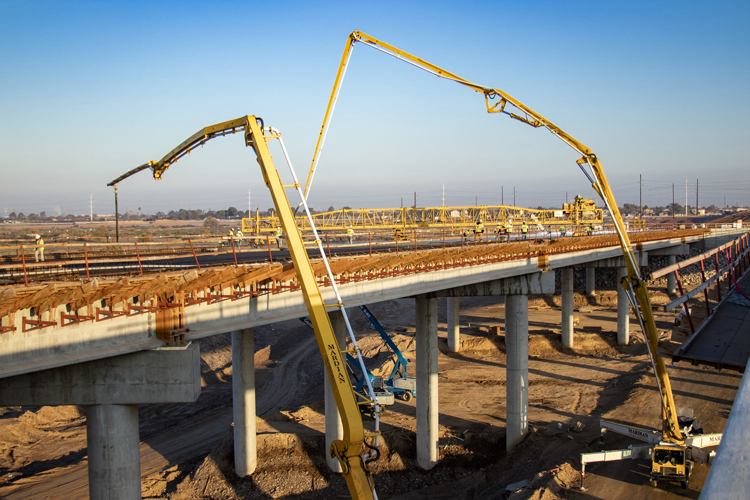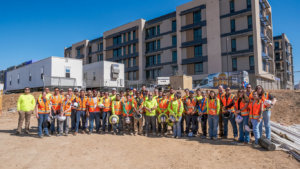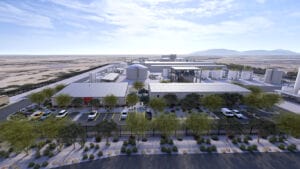It’s just 22 miles, but the impact of the soon-to-be-completed South Mountain Freeway will be felt near and far in Arizona.
The first-of-its-kind public-private partnership freeway development in Arizona is nearly 80 percent completed, with stretches of the freeway in the Ahwatukee area already being utilized on a short-term basis as work continues. The $1.7 billion freeway is expected to be completed in November, opening up a much-needed route between the West Valley and the Southeast Valley.
“While the project remains on schedule, it’s worth noting that ADOT is delivering the Loop 202 South Mountain Freeway three years sooner than originally anticipated and at a cost savings exceeding $100 million by using an innovative approach to selecting the team to design, build and maintain the highway,” said Dustin Krugel, public information officer for the ADOT. “The freeway is scheduled for full completion in 2020, although traffic is expected to be using the freeway earlier.”
The public-private partnership operates under the Connect 202 Partners label and is made up of Fluor Enterprises, Granite Construction, Ames Construction and design firm Parsons Brinckerhoff, together with leading highway maintenance services contractor, DBi Services.
Unlike other freeway projects in the Valley, the South Mountain Freeway will open with all of its lanes, three regular commuter lanes and one HOV lane. Past freeway projects, like the Loop 101 through Scottsdale, opened with fewer lanes than they have currently.
“The good thing about it is it is being built to its ultimate size, four lanes in each direction,” said Martin Perez, program manager for the City of Phoenix. “There’s not going to be two lanes and then more construction.”
Another unique aspect of the South Mountain Freeway is it will feature Arizona’s first diverging diamond interchanges, one at Desert Foothills Parkway and the other at 17th Ave., both in Ahwatukee.
While all of the news is positive right now, getting to this point in construction didn’t come without some struggles. Krugel noted that there were several difficult construction challenges on the project, including one that will be tackled after the freeway is completed. Krugel cited the challenge to maintain access to businesses and building bridges over the railroad tracks between Van Buren Street and Buckeye Road. Also, crews had to remove heavy rock between 51st Ave. and 32nd Lane in a center segment of the freeway. Also, it took a lot of juggling and adjustments for crews and the public during construction along Pecos Road in Ahwatukee.
And the final challenge will come when the rubberized asphalt is applied during portions of the freeway that currently have traffic, which will require closing lanes.
Throughout the whole process, Krugel said that staff worked overtime to maintain communication with the contractors as well as the public.
“The South Mountain Freeway project communications team distributes a weekly traffic advisory to more than 20,000 stakeholders,” Krugel said. “In addition, this is the first ADOT project that has its own social media accounts (Facebook @SouthMountainFreeway and Instagram @SouthMountainFreeway) to reach its audiences.”
As the finish line for the South Mountain Freeway nears, it marks the end of a long, contentious history dating back to 1985 when the freeway was originally passed by Maricopa County voters. Years turned into decades as community groups and the Gila River Indian Community voiced opposition to the project due to the impact it would have on the land. Ultimately, plans that were satisfactory to the GRIC were made and the freeway project pushed ahead in 2016.
Frequent commuters on the I-10 from the West Valley are anticipating less traffic, as an estimated 120,000 to 190,000 vehicles are expected to use the South Mountain daily by 2035.
Another group is anxiously waiting for the South Mountain to finish: Developers. There are already projects underway, including Trammell Crow Company’s West 202 Logistics Center, a 554,000 square foot industrial building that is nearing completion less than a mile from the new freeway.
“It’s a project that we’re really excited about and we’ve had a ton of interest in it,” said Cathy Thuringer, principal for Trammell Crow Company, who expects to be done with the West 202 Logistics Center by August. “I think we are going to be able to lease it out in a heartbeat.
But this would have had a lower liklihood of happening had the 202 not been built.”
Another development that is already far down the planning road is a mixed-use complex on 100 acres owned by Kitchell Corp. at 59th Ave. and Baseline in Laveen. Already, Sprouts Farmers Markets has made plans to build a new store, and Harkins Theatres recently announced its plans for a 12-screen multiplex.
“There are really a lot of young professionals in Laveen, and now we have a new gateway into that area to really showcase what’s available,” said Lori Collins, Deputy Economic Director for the City of Phoenix. “It gives us the opportunity to create an entirely new employment corridor.”
“Along 59th Avenue, there’s a lot of farmland that is ripe for development,” added Perez. “We have a goal in the city to develop a tech corridor similar to the Price Corridor in Chandler.”




